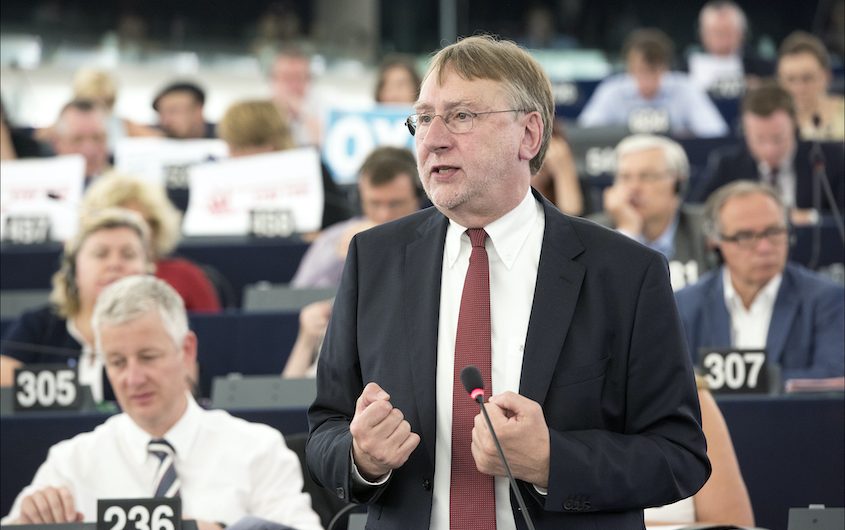
European Parliament via Flickr
One Year after U.S. Elections: What Is the Status of the Transatlantic Trade Relationship?

Bernd Lange
Chair of Committee on International Trade, European Parliament
Bernd Lange is Chair of the European Parliament's committee on International Trade and Standing rapporteur for the EU-US trade relation since 2014. Previously he was Spokesman on trade policy on behalf of the Socialist Group in the European Parliament. He was a Member of the European Parliament in 1994-2004 and again from 2009 until present time. 2005-2009 he was Head of the economics, environment and European affairs section of the German Trade Union Federation for the Lower Saxony-Bremen-Saxony/Anhalt region. He began his career as a secondary school teacher.
Honeymoon Is Over, But Both Sides Committed to Make It Work
One year ago, all of us in Europe were eagerly waiting for the results of the U.S. elections. The Trump years had been devastating for transatlantic trade and investment relations. In 2018, the United States imposed additional tariffs on EU imports of steel and aluminum products, stating that these products posed a national security threat to the United States. €6.4 billion worth of trade was affected. Apart from these illegal unilateral measures, the former United States Trade Representative, Robert Lighthizer, used his last months in office to block the appointment of Dr Ngozi Iweala as new Director-General of the World Trade Organization. It once more proved the United States wanted to act unilaterally and saw no merits in the multilateral system.
The EU sighed a breath of relief when Biden took office. The appointment of the very experienced Katherine Tai as United States Trade Representative led many in the EU to believe that from now on everything would be different.
What is certain is that we now have a much more constructive partner to engage with. We see strong willingness on both sides for reengagement. One of the first significant international moves by the Biden administration, apart from rejoining the Paris Agreement, was to unblock the appointment of the new WTO DG. The EU-U.S. summit in June 2021 was successful in the sense that it established forums to tackle joint challenges. It was encouraging that after the EU offer to establish a Trade and Technology Council that had been on the table for a few months, the U.S. side agreed to its establishment. On Airbus-Boeing, a dispute that has lasted 17 years, both sides have agreed to a ceasefire, so all tariffs are suspended for a period of five years. On October 31, the United States and the European Union also agreed that the United States would remove tariffs on historical levels of EU steel and aluminum exports. In return, the EU decided to suspend its counterbalancing measures. Both sides also agreed to pause their WTO disputes related to steel and aluminum. This agreement will bring great relief to many sectors that were targeted by these tariffs.
But it’s not all milk and honey. Some bilateral trade irritants persist and we continue to have divergences on quite a few issues. The steel and aluminum tariffs are only partly removed. The section 232 branding of EU steel and aluminum exports as a national security threat is still there. While this is an important step in de-escalation and both sides are committed to working together, it will require a lot of efforts to fully resolve the dispute created under the previous administration. In addition, one needs to bear in mind that the EU agreed to a tariff- rate quota, which is difficult to reconcile with WTO rules. It’s also still not clear whether the United States is as willing as the EU to invest in the future of the World Trade Organization. While ambassador Tai’s speech on the WTO was reassuring in the sense that it wants to make the Ministerial Council at the end of November a success, there are still no specific proposals on the table from the United States regarding the reform of the organization. The current U.S. administration is very much focused on the domestic agenda and many of its international engagements should also be seen in this light.
Where the transatlantic partners agree, they lead the way and create a platform for global change. The list of possible issues to set a new, global agenda for change has possibly never been greater.
I hope that we can use the positive momentum of the last months to create a new dynamic. This would not only be in the interest of the EU and the United States, but also the rest of the world, since the importance of a healthy and vibrant transatlantic relationship extends much beyond the bilateral ties. Where the transatlantic partners agree, they lead the way and create a platform for global change. The list of possible issues to set a new, global agenda for change has possibly never been greater.
The climate crisis demands answers from nations that want to shape the world we live in for future generations. Reducing carbon emissions, encouraging the growth and trade of green goods and technologies, and delivering these technologies to other countries are concrete steps where the EU and the United States should cooperate. The EU has presented a proposal for a Carbon Border Adjustment Mechanism, putting a price on the carbon emitted during the production of carbon-intensive goods. This is a beginning, but not more than that. This system would be much more powerful and impactful if it were applied by more countries. And who but the United States is in a better position to leverage the power of its economy for the benefit of future generations? The transatlantic partners’ recently announced intention to work together on the production of green steel and to negotiate a Global Arrangement on Sustainable Steel and Aluminum is definitely to be welcomed. Yet, it remains to be seen whether these newly announced actions will lead to greener steel on a global scale. The WTO compatibility of the announced actions is an issue I will pay close attention to.
When engaging with the United States, we have to be careful to find solutions that fit within the multilateral trading system, particularly now as we are entering a crucial phase for its future. The upcoming ministerial conference will be a watershed moment, where the members of the WTO must prove that they want to make the organization fit for the 21st century. Clearly, the rules need to be updated to reflect the emergence of new trading powers which do not function as market economies. The appointment of new members to the Appellate Body is still blocked by the United States, which means that currently more than 20 cases are appealed into the void. The continued stalemate makes breaking the multilateral rules more appealing every day. The current rules are not fit for purpose, and many will look to the transatlantic partnership for answers about whether we will update the rulebook or tear it to shreds.
When engaging with the United States, we have to be careful to find solutions that fit within the multilateral trading system, particularly now as we are entering a crucial phase for its future.
Finally, values—there is no closer partner for Europe in this regard than the United States. Both sides are committed to putting the interests of workers and ordinary people at the center of their trade policies. Coordinated action to fight abuses of human rights nature, coercion, and unfair trading practices would go a long way. If we have learnt anything at all from the last years, it must surely be that trying to tackle these problems alone will not solve them. In the worst case, it alienates allies.
The first order of business, therefore, has to be that we talk and agree on a common agenda.
One specific and promising platform for this is the EU-U.S. Trade & Technology Council, as it is a forward-looking forum that is part of our positive agenda. Within the TTC, both sides want to enhance the kind of trade and technologies we want to see as democracies. It held its augural meeting at the end of September, only three months after it had been agreed at the EU-U.S. summit. It has great potential to deliver outcomes that positively impact peoples’ daily lives. But for this to succeed, certain conditions need to be met. First, it should focus on clear deliverables. There is a lot of low-hanging fruit out there to be harvested. Second, it needs to meet at regular intervals so that both the political and the technical level know when to deliver.
As great as the challenges are, there is hope. Although they have suffered, Europe and its member states recognize the importance of the transatlantic relationship. I see this in my own home, Germany, where a new coalition is currently being negotiated among three parties that have widely differing views on subjects ranging from taxation to fighting climate change. What they all agree on, however, is that in international relations we have no closer ally than the one in Washington.








